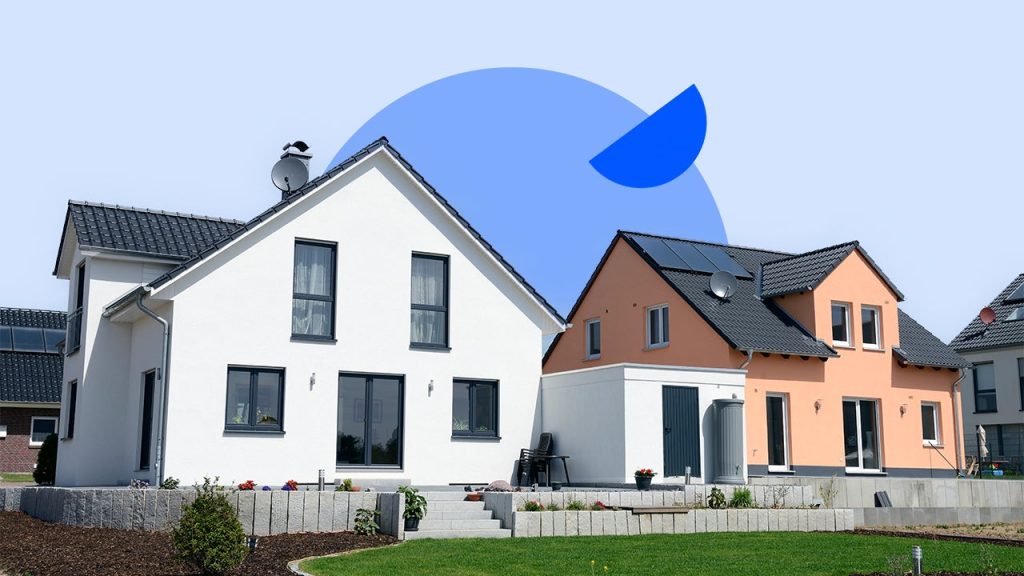Key takeaways
- You can use home equity to buy another house if you have enough of an ownership stake in your residence and meet other eligibility requirements.
- The most common ways to tap your equity are via a home equity loan or home equity line of credit (HELOC).
- Purchasing property with home equity can be cost-effective and make you a more competitive buyer.
- But it comes with certain risks and downsides: trading assets for debt, losing tax deductions, and risking your home if you miss payments.
For homeowners, home equity is an incredibly valuable asset – so valuable, in fact, that they can tap it for a variety of expenses. They can even leverage it to buy a second home, either outright or in part. Depending on the size of their ownership stake, they can borrow serious six figures — even as much as $1 million — via a home equity loan or home equity line of credit (HELOC).
Can you use a HE loan or HELOC to buy a second home? Sure, if you have enough equity and meet the eligibility requirements. But perhaps a better question is: Should you use one of these home equity tools to buy a second home?
While using home equity for a second home purchase is often convenient and cost-effective, it also comes with certain risks. Let’s explore how this financing method works, including its pros, cons and alternatives.
How to use home equity to buy another home
If you’d like to tap your home equity to purchase a second home, you’ve got several options. The two most common are a home equity loan and a HELOC.
While there are similarities between these two products (for example, they’re both second mortgages that require you to put your house up as collateral), there are also important differences. Here’s how each one works.
Home equity loans
Home equity loans let you borrow a lump sum from the ownership stake you’ve built in your home. The amount you can take out depends on how much equity you have in your home and its worth, based on your home’s current fair market value.
For example, let’s say your home is worth $500,000, and you have accrued $300,000 in equity (with $200,000 left on your mortgage). Most lenders will let you access up to 85 percent of this equity stake. In this case, that would be $255,000. (To figure out how much you might be able to borrow, check out Bankrate’s home equity calculator.)
With a home equity loan, you’ll receive the money all at once, and can use the funds however you’d like. For instance, if you’re eyeing a vacation home, you could put the money toward a down payment and closing costs. Then, you’ll repay the home equity loan in monthly installments – at a fixed interest rate – over the term, which can be up to 30 years.
HELOCs
HELOCs offer a revolving line of credit (like a credit card), meaning you can take out money gradually, rather than receiving it in a lump sum. Like home equity loans, you can generally borrow as much as 85 percent of your equity with a HELOC. However, HELOCs usually have variable interest rates that can rise or fall based on the current economic conditions.
During the initial draw period (the first five to 10 years of your HELOC), you can withdraw funds as needed and only repay the interest on what you’ve borrowed. If you do repay some principal, your available credit rises, and you can withdraw the funds again. After the draw period, you’ll enter the repayment period, which usually lasts between 10 and 20 years. Withdrawals are no longer allowed, and you’ll need to pay back the HELOC principal and any additional interest within that time frame.
What are the pros and cons of using home equity to buy another house?
Not sure whether you should use your equity to purchase a second home? Weigh up these pros and cons.
Pros of using home equity
- You won’t have to touch your savings. By taking out a home equity loan or HELOC, you can get the cash you need to buy another home, without depleting your bank or investment account.
- You can keep your current home/mortgage. You don’t need to sell or rent out your house to get funds for another home purchase and can leave your low-interest-rate mortgage, if you have one, untouched.
- You’ll be a more competitive buyer. With the funds from your home equity loan, you can make a larger down payment on a new home — or even buy it outright. (See “Using home equity for down payments” below.) That could make you more attractive to sellers.
- You can potentially borrow at a lower cost. Home equity loans and HELOCs are secured by your property. As a result, they tend to have lower interest rates than unsecured loans, like personal loans. Your exact interest rate will depend on your financial profile and lender, of course.
- You’ll have a long time to repay. Home equity loans and HELOCs generally have long repayment periods, often up to 30 years.
Cons of using home equity
- You could lose your home. Your primary residence serves as collateral for your home equity loan or HELOC. If you can’t repay it, your lender could take your house.
- You’re trading in hard-earned equity for more debt. In addition to your existing mortgage, you’ll also be responsible for the home equity loan or HELOC, as well as any mortgage on your new property. That’s a lot of debt to deal with, especially if you’re like the 25 percent of U.S. adults in Bankrate’s 2024 Emergency Savings Report who say paying down debt is a higher priority this year. Or the 36 percent of U.S. adults who are prioritizing both debt repayment and increasing emergency savings.
- You might end up underwater. If you give up a big chunk of your equity and property values decline, you could end up owing more on your home than it’s worth (especially if you’ve multiple home-secured loans). As a result, you’d go into negative equity – otherwise known as being underwater on your mortgage.
- You’re on the hook for closing costs. Like primary mortgages, home equity loans and HELOCs come with closing costs. On average, these costs range from 2 to 5 percent of your total loan amount; sometimes, they’re closer to 1 percent. Still, it’s an additional expense.
- You might pay more interest. While cheaper than unsecured debt, second mortgages carry higher interest rates than primary mortgages and refinances. You will probably also lose some tax advantages (see below).
Tax breaks with home equity loans
If the use is for a second home, you might lose out on one fundamental plus of home equity financing: the ability to deduct the loan interest come tax time.
“The IRS stipulates that for the interest to be deductible, the loan must be used to buy, build or substantially improve the residence that secures the loan,” says Dennis Shirshikov, head of growth at Awning.com, a real estate investment platform. So, if you use your primary residence as collateral for an HE loan or HELOC, and then put the money to buy a beach bungalow, mountain cabin or any other different property, you can’t take a tax deduction on the interest. The idea is, you’re supposed to be enhancing your current home — the one you’re borrowing against.
There’s one way the tax break might still apply with a second-home purchase, Shirshikov says: “Buying adjacent land or property can be considered part of this [home enhancement], especially if it’s demonstrable that such an acquisition improves or complements the value or utility of the main residence.” For example, you use home equity funds to acquire some wooded acres behind your place to clear and build a little guest house; or you buy the house next door and connect it to your residence.
Shirshikov recalls a case where a homeowner used a home equity loan to purchase a vacant lot adjacent to their primary home. “The rationale was that this purchase prevented a potentially obstructive development on that land, thereby preserving the home’s view and value,” he says. “The IRS accepted this as a substantial improvement to the residence.”
Using home equity for down payments
Given the realities of today’s real estate market, coming up with down-payment cash is a big sticking point for would-be buyers. According to Bankrate’s February Down Payment Survey, more than half of aspiring homeowners say they can’t afford a down payment and closing costs right now, because the cost of living is too high (51 percent) or their income is not high enough (54 percent). These are the key reasons they’re holding off on homeownership.
$64,000
The median down payment for a U.S. home in June 2024, about 16% of the median sales price. That sum is up 14% year-over year.
Source:
ATTOM
If you have trouble coming up with a down payment, then tapping into your home equity could be worth considering. Just one catch: Not all lenders will let you put home equity money towards a new home, if you’re financing the rest of it with a mortgage.
There isn’t a widespread rule in the mortgage industry against it, says Matt Dunbar, senior vice president, southeast region for Churchill Mortgage. But, because a down payment is supposed to be a no-strings cash contribution from a buyer, an issue can arise if it’s money that must be repaid. “The critical aspect for lenders when evaluating such scenarios is ensuring the borrower’s debt-to-income (DTI) ratio accurately reflects all financial obligations, including the new debt incurred from the HELOC” or HE Loan, he explains.
Basically, the lender wants to be sure it’s making “a well-informed decision regarding the borrower’s financial capacity,” as Dunbar puts it. He recommends getting and depositing the home equity money well before your mortgage application, to give the funds time to season (and for your credit report to reflect the debt).
Keep this in mind when choosing a lender, as institutional policies vary. “Some deposit banks or credit unions may not allow the practice, but stand-alone mortgage companies will allow HELOC funds to be used for a second home or an investment property,” says Jay Garvens, a Colorado Springs-based real estate investor and business development manager, also with Churchill Mortgage. “In fact, the standard loan application disclosure section asks if any of the down payment funds are borrowed, so this practice isn’t out of the ordinary.” You might also double-check the fine print of your home equity loan or HELOC contract, to make sure it doesn’t prohibit buying or investing in real estate.
Should you use a home equity loan to buy an investment property?
If you don’t plan on inhabiting your new home, you can also use equity to purchase an investment property — a residence you’re going to flip or rent out for income. (Again, you’ll need to work with a lender that lets you put your home equity loan funds toward a down payment.) Let’s run through some of the benefits and drawbacks of doing so.
On the plus side, if you’ve built up a lot of equity, your home equity loan or HELOC lets you access a large amount of money. That’s important when buying investment properties, which have stricter eligibility criteria than second homes and typically require a 15 to 25 percent down payment.
At the same time, there are risks involved in using equity to finance an investment property. Ideally, your new property will generate consistent income (via the rents or leases) to help you repay your home equity loan or HELOC on time – but, unfortunately, that’s not guaranteed.
Let’s say you remodel your new investment property with the intent to sell it for a profit. What happens if you can’t attract a qualified buyer? Or, what if you put the home on the rental market but struggle to find a reliable tenant? In either case, you’ll still be responsible for paying back what you’ve borrowed – and if you can’t afford it, you could lose your property.
Alternatives to using a home equity loan when buying a second property
Home equity loans and HELOCs are a popular financing tool these days – but they aren’t your only option. In fact, “just because you can, doesn’t mean you should,” says Greg McBride, chief financial analyst at Bankrate. “You may have a pile of equity in your primary home, but borrowing from that equity to purchase a second home is a costly proposition with many home equity rates now in double digits. That is a high cost of borrowing that puts your primary home on the line in the event of default.”
If you do think twice before tapping it to purchase another home, here are a few alternatives to consider. Some options offer funding for the most of the purchase, others are more to cover the upfront expenses (down payment, closing costs).
- New mortgage: “In most cases, prospective second home buyers would be better off taking a mortgage on the property they’re acquiring instead,” says McBride. By taking out a loan that uses the new property as collateral, the mortgage interest will be tax-deductible if you itemize (up to the overall mortgage-debt limit, which applies to all your home loans). Of course, you’ll need enough cash on hand to cover the down payment.
- Retirement savings: You might be able to put as much as $50,000 towards a second home by taking out a loan from your 401(k) plan. Not all employers provide this option, but if you can get one, you’ll have five years to repay it (less if you leave your job), without penalties or paying taxes.
- Personal loans: With a personal loan, you can typically borrow as much as $50,000; some lenders will even offer up to $100,000 for qualified applicants. However, personal loans tend to have higher interest rates than home equity products. Also, most lenders won’t let you use an unsecured personal loan on a mortgage-financed purchase. If you can do a cash deal, though, the personal loan could help you get over the finish line.
- Cash-out refinance: When you take out a cash-out refinance, you’ll replace your current mortgage with a newer, bigger one. The new loan will include your remaining mortgage balance, as well as a portion of the equity you’ve built over the years – which you can use immediately for any purpose.
- Reverse mortgage: If you’re 62 or older and have substantial equity in your home, you could swap some of that equity for cash with a reverse mortgage. Under this arrangement, you’ll receive tax-free payments from your lender, which must be repaid when you move out, sell your home or pass away.
- Private lending/investing: You might also consider borrowing from a peer-to-peer (P2P) lender for your home purchase. Provided by individuals or groups of investors, P2P loans are typically unsecured and have varying eligibility criteria, terms and interest rates. Another option: a shared equity agreement, in which an investment company gives you a lump sum in exchange for a piece of your primary home’s future (presumably appreciated) value.
- Hard money loan: Hard money loans (also known as bridge loans) are a short-term form of borrowing that’s often used by house flippers. Like home equity loans, they are secured by the property they’re tied to rather than an applicant’s credit score or personal finances. Funded by private lenders or investor groups, hard money loans carry high interest rates and brief repayment terms, often less than one year. As their synonym suggests, they’re intended to “bridge” the gap in your funds until you can find other financing or sell the home.
- Seller financing: Owner financing is another alternative to using a home equity loan to buy another house. Through this arrangement, the homeowner or seller, rather than a bank or mortgage lender, provides the buyer with some or all of the funds for the purchase. The buyer repays the seller, with interest, on a mutually agreed-upon schedule.
FAQs
-
There’s no set length of time, but be aware that you’ll need to repay the balance on your home equity loan before you sell (or technically, close). Ideally, you’ll earn enough money from the sale to pay off the remainder of your loan, as well as whatever’s left on your primary mortgage. However, if the proceeds won’t be enough to settle these debts, you may want to hold off on selling until you increase your equity stake, so the money from the sale can fully cover your loan balance.
-
Not necessarily, and not often — one big reason lenders limit the amount of home equity you can borrow against is to ensure you don’t end up owing more on your home than what it’s worth. But becoming upside down or underwater can happen if your home’s value drops significantly after taking out the loan, making it worth less than the sum total of all your home-secured debts.
-
It depends on your plans and goals for the new place. If you only need a certain amount of money for a down payment and prefer a predictable schedule of fixed repayments, a home equity loan is a better bet.On the other hand, maybe you want to renovate the property within the next couple of years, but you aren’t sure how much it’ll cost. In that case, you might take out a HELOC to both buy and fix up your second home, since it lets you withdraw money on an ongoing basis as needed.
Additional reporting by Mia Taylor
Read the full article here
















